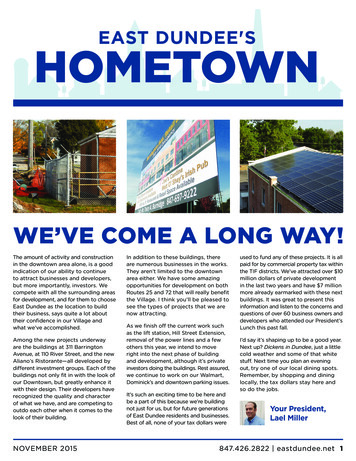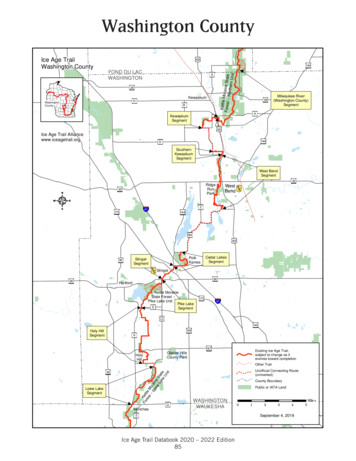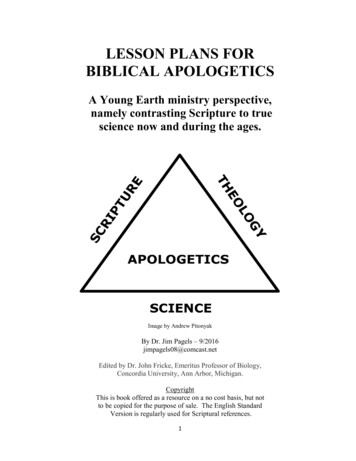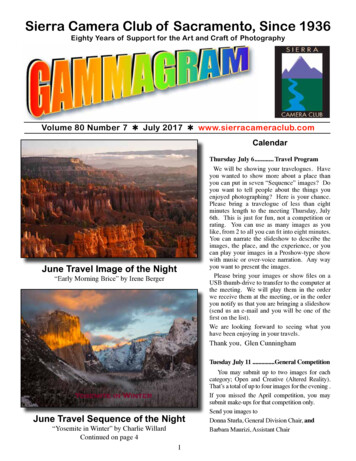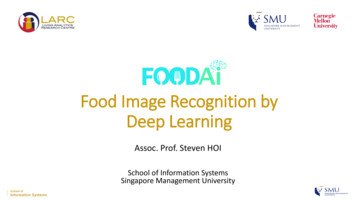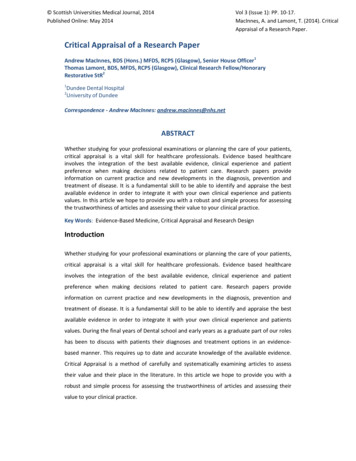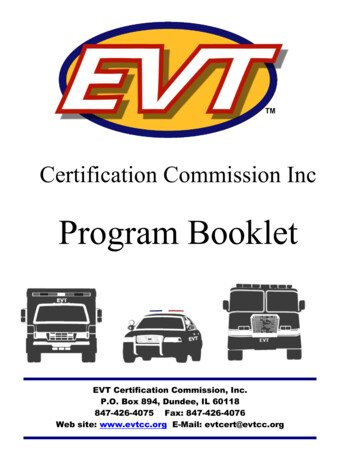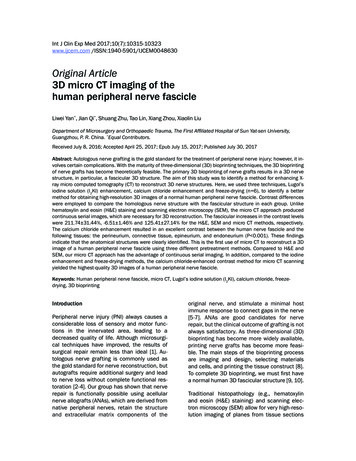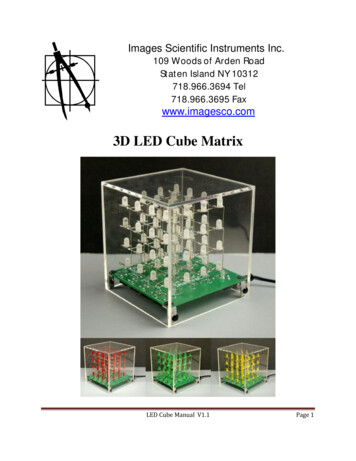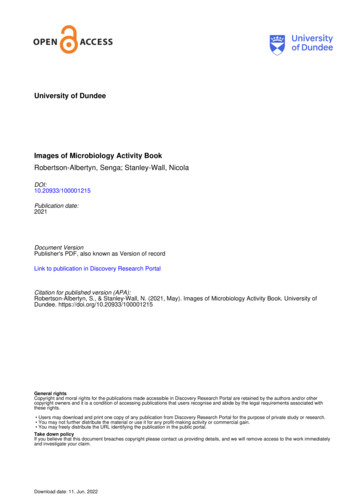
Transcription
University of DundeeImages of Microbiology Activity BookRobertson-Albertyn, Senga; Stanley-Wall, NicolaDOI:10.20933/100001215Publication date:2021Document VersionPublisher's PDF, also known as Version of recordLink to publication in Discovery Research PortalCitation for published version (APA):Robertson-Albertyn, S., & Stanley-Wall, N. (2021, May). Images of Microbiology Activity Book. University ofDundee. https://doi.org/10.20933/100001215General rightsCopyright and moral rights for the publications made accessible in Discovery Research Portal are retained by the authors and/or othercopyright owners and it is a condition of accessing publications that users recognise and abide by the legal requirements associated withthese rights. Users may download and print one copy of any publication from Discovery Research Portal for the purpose of private study or research. You may not further distribute the material or use it for any profit-making activity or commercial gain. You may freely distribute the URL identifying the publication in the public portal.Take down policyIf you believe that this document breaches copyright please contact us providing details, and we will remove access to the work immediatelyand investigate your claim.Download date: 11. Jun. 2022
School of Life SciencesUniversity of DundeeImages ofmicrobiologyactivity book
Introduction1This booklet accompanies the University of DundeeImages of Microbiology book.It contains activities that are suitable for variouslearning stages.You will need your University of Dundee Imagesof Microbiology book to help you completethese activities.We hope you have fun!Senga and NicolaDr. Senga Robertson-Albertyn is a researcher basedin the Division of Plant Sciences at the University ofDundee and she designed these activities. Herresearch focuses on the interactions between plantsand microbes, and the beneficial roles microbes canplay in plant health and how the plant controls itsmicrobiota. She is supported by the Horizon 2020Framework Programme Innovation Action ‘CIRCLES’(European Commission, Grant agreement 818290)awarded to the University of Dundee.Prof. Nicola Stanley-Wall is a microbiologist whostudies how bacteria form social communities calledbiofilms. She and her daughter (age 10) providedinput during the development of the booklet.
Making mineralsSkin microbesMatch the descriptions in your Images of Microbiologybooklet to help colour these microbes (or use anycolours you like).Match the descriptions in your Images of Microbiologybooklet to help colour these microbes (or use anycolours you like).23FungusMagnification: 320xBeauveria caledonica can make new minerals. Thethin threads (hyphae) are the growing and branching“body” of the fungus. Sometimes these threads growtogether and make thicker strands covered with ajelly-like coating. The spheres are crystals of a coppermineral that the fungus has made.MIXED SAMPLENo magnificationSkin is covered by many different microbes. When wetouch a surface, they can be transferred, in this caseto an agar plate. Scientists use agar plates to growmicrobes in their labs, so they can study them andlearn more about them.
Soil microbesMicrobe word searchMatch the descriptions in your Images of Microbiologybooklet to help colour these microbes (or use anycolours you like).Can you find all 17 microbe related words in this wordsearch? Words can be found left to right, up and downand diagonally – keep an eye out for the tricky onesthat are backwards.CKPWQZPSDOXJXGXWHFID4MIXED SAMPLEMagnification: 2xThere can be more microbes in a teaspoon of soil thanthere are people on Earth! They help plants to grow bymaking it easier for them to get important elementslike nitrogen and phosphorus from the VWAKCXXCCVMLIFOIBPQSZ5
Bacterial structuresDesign your own microbesMatch the descriptions in your Images of Microbiologybooklet to help colour these microbes (or use anycolours you like).Think about what you have learned so far and createyour own agar plate below. Be as creative as you like,microbes come in all colours, shapes and (small) sizes!67BACTERIAMagnification: 8xMany bacteria form elaborate, wrinkly structureswhen they grow as large groups on a solid surface.There are billions of individual bacteria piled on topof each other in this image, and they are thoughtto form these structures to improve the accessof the cells to fresh air.Created with BioRender.com
8Magnified microbesDesign a hand printWe have zoomed in on some of the images.Can you match them with the photographsin your Images of Microbiology booklet?Think about the handprint images in Images ofMicrobiology booklet. Why not add microbes to thehand below? Be as creative as you like as microbescome in all colours, shapes and (small) sizes!1.2.3.4.5.6.Created with BioRender.com9Created with BioRender.com
Magnified microbesMicrobe crossword puzzleWe have zoomed in on more of the images. Can youmatch them with the photographs in your Imagesof Microbiology booklet?Your Images of Microbiology booklet containsall the answers to these crossword clues.Can you answer them all?1101.22.1134567893.104.111213Across1.5.6.Where are microbes found?12. These microbes can grow long filamentscalled hyphae to search for nutrients4. Microbes that live in soil can helpto grow better13. Some microorganisms use these tomove around5. The name given to a community ofmicrobes living in a particular environment2. Another word for waterproofDown6. In a laboratory what are microbes oftengrown on?3. Trypanosoma cruzi is an example ofwhat type of microbe?7. Some microbes produce thesecompounds to prevent other microbesfrom growing5. We use these to be able to see microbes9. Something that is given to you to helpprotect you from infection11. An organism that is composed of justone cell8. These are composed of billions ofbacteria living together and can bewaterproof10. A food that can be made with the helpof microorganisms
Guess whoUse the descriptions in the Images of Microbiologybooklet to work out which microbe fits each description.1. Which of us is waterproof (hydrophobic)?ABCDE12Answers132. Which of us uses a “tail” (called flagella) to swim around?ABCDE3. Who grows threads (hyphae) to explore for food (nutrients)?ABCDE4. Who can produce antibiotics and colour pigments?ABCDE5. Which of us grow in soil and help plants to get nutrients?ABCDE
Microbe word BJZAEYZUNHDESEQTCLSIMIYLRMagnified microbes – page SMICROBIOLOGYSCIENCE1. Antibiotic resistance2. Antibiotics from soil153. Biofilm building4. Bacterial colonies5. Bacterial reactions6. Moving bacteriaMagnified microbes – page 10Microbe crossword puzzle111m i13fl2e v e r y w h e rydroph5m i c r o b i o m eib7ca n t i b i o trco910sv a c cchc r o b eepea g e l l asee1. Leishmaniasis2. Skin microbes3. Making minerals4. Living together5. Microbes competing6. Microbe care3pp l a n t sr6a g a ri c si8bti n eo12f u n g iilm4
Guess who1. Which of us is waterproof (hydrophobic)?ABCDE162. Which of us uses a “tail” (called flagella) to swim around?ABCDE3. Who grows threads (hyphae) to explore for food (nutrients)?ABCDE4. Who can produce antibiotics and colour pigments?ABCDE5. Which of us grow in soil and help plants to get nutrients?ABCDE
dundee.ac.ukThese worksheets were designed by Dr. Senga Robertson-Albertynwho is a researcher based in the Division of Plant Sciences at theUniversity of Dundee. Her research focuses on the interactionsbetween plants and microbes, more specifically Senga investigatesthe beneficial roles microbes can play in plant health and how theplant controls its microbiota.The work of the scientists featured in this booklet was funded by:This project has received funding from the European Union’sHorizon 2020 research and innovation programme under grantagreement No 818290.The project was developed in partnership with:Dundee Science Centre (DSC)University of DundeeNethergate, Dundee, DD1 4HNUnited Kingdom 44 (0)1382 383000contactus@dundee.ac.uk University of Dundee 2021Design: Creative Services, University of DundeeWe would love to hear from you.Tweet us your thoughts, questions,and photographs:@UoDLifeSciencesThe University of Dundee is a registered Scottish Charity, No. SC01509623109
Images of Microbiology Activity Book Robertson-Albertyn, Senga; Stanley-Wall, Nicola DOI: 10.20933/100001215 Publication date: 2021 Document Version Publisher's PDF, also known as Version of record Link to publication in Discovery Research Portal Citation for published version (APA): Robertson-Albertyn, S., & Stanley-Wall, N. (2021, May).
